Porsche 64 (1939-1940) – The Ultimate Guide
In 1935, the first Volkswagen prototypes were ready for testing, internally referred to as Porsche type 60. After a few prototypes, a series of 30 Volkswagen test cars were made by Daimler-Benz AG in 1937.
With the Volkswagen nearing its production, the idea of Porsche’s own series production sportscar was also born. The plan was to use Volkswagen’s mechanicals, but it being the govermental project, the agreement couldn’t be settled to use the parts by a private car company. So, Porsche family had to give up the idea of their sportscar using Volkswagen components.
The following brainstorm led them to a Porsche F-Wagen (Ferdinand-Wagen) with midmounted watercooled 1.5-litre V10. It was designated as the type 114 and was put on paper down to details. Although Porsche design office was huge, very successful and had a large number of customer projects going on, Porsche’s own sports car, and now with 10-cylinder engine, was too much to handle.
The idea of the V10 car was sold to KdF (Kraft durch Freude, a state-operated organization of Nazi Germany) and new type number was assigned to the now KdF R-Wagen (Rennwagen, race car). It was internally called as Porsche type 116, but this project didn’t materialize neither. In the meantime Volkswagen was getting ready for production and was renamed as KdF-Wagen in 1938.
Motorsport was very ‘in’ at the time and KdF could still use a competition car for the marketing purposes.
In 1936 a coalition called Rome-Berlin Axis had been formed between Germany and Italy and later fixed with the Pact of Steel signed by the nazi Adolf Hitler and fascist Benito Mussolini. It formalized the Rome-Berlin Axis agreement, linking the two countries politically and militarily. Both countries had been very poor and this had helped the leaders to become dictators.
As Germany became a bit wealthier, it became the stronger partner and as the time passed, Mussolini had to accept Hitler’s wishes more and more.
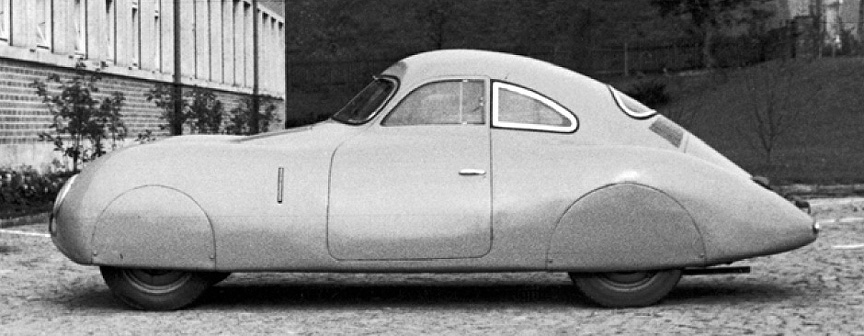
NSKK (Nationalsozialistisches Kraftfahrkorps, National Socialist Motor Corps), a paramilitary organization of the German Nazi Party, started to organize the Berlin-Rome road rally to happen on September 27, 1938. Just a week before the start of the rally the so-called Sudeten Crisis escalated. Hitler had set his eyes on the areas of German-speaking Czechoslovakia earlier and already in 1936 Czechoslovakia started to build border fortifications. Officially it was Mussolini who suggested a conference in Munich regarding the issue and on September 29, 1938, Hitler, Daladier (France) and Chamberlain (GB) met and agreed to Mussolini’s proposal which was prepared by nazi Hermann Göring. The Munich Agreement was signed, accepting the immediate occupation of the Sudetenland. Because of the Sudeten Crisis, the 1938 Berlin-Rome race did not happen, but as the event was planned as a new tradition, the race was scheduled also for 1939.
For the 1939 race, in September 1938 a project was started to create KdF’s Berlin-Rome competition car. It was a car using type 60 KdF-Wagen’s mechanicals with design from Porsche 114 project. The KdF Berlin-Rome car was called as type 64. Its body design project number was 60 K10. K10 meant it was the 10th body (Karosserie 10) for the type 60 chassis. The type 64 cars were built using 1938 KdF VW38 chassis and the chassis numbers therefore begun with 38. The side view of the ‘on paper only’ type 114 and the type 64 was very similar. There were many body versions of the 114 and the type 64 got its front look from the narrow cockpit 114. Having the powerless engine, the type 64 had to be as aerodynamic as possible. And the narrow cockpit made it look very cool. These aluminium-bodied cars were designed by Erwin Komenda.
No. 1 Porsche Type 64
The first KdF Berlin-Rome competition car, chassis number 38/41, was finished on August 19, 1939. Thanks to the streamlined body, the small 4-cylinder aircooled 1100 cc flat engine was capable of achieving more than 80 mph/130 km/h average speed on drives between Stuttgart and Berlin. The top speed was 95 mph/153 km/h.
On September 1, 1939, Hitler invaded Poland and the Berlin-Rome road race could not happen again.
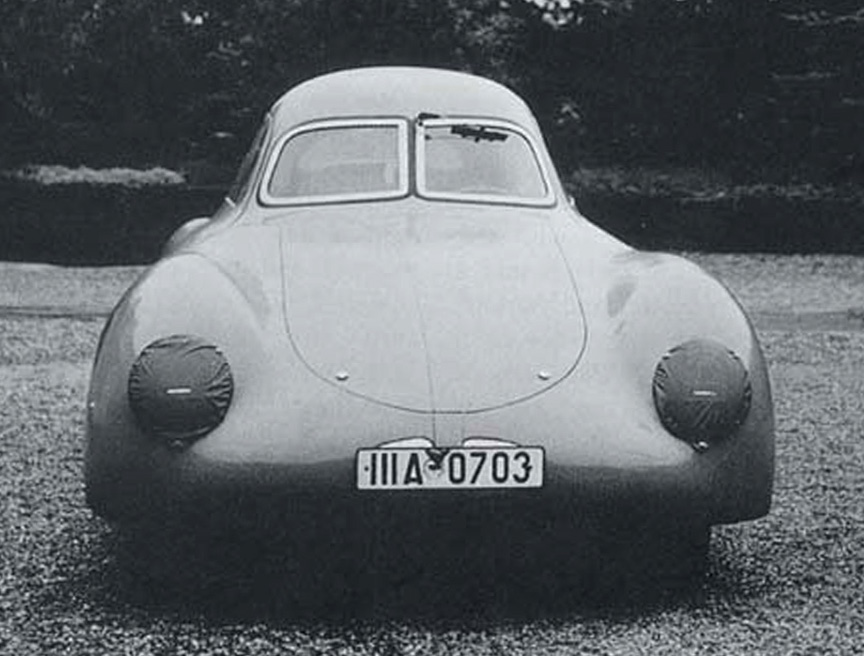
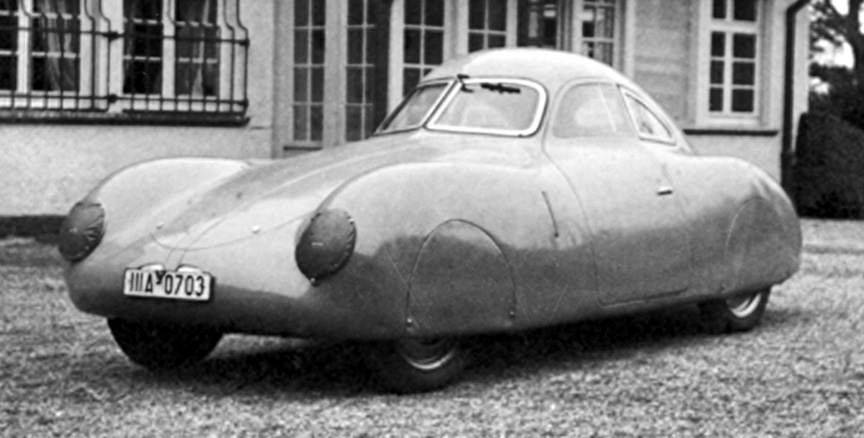
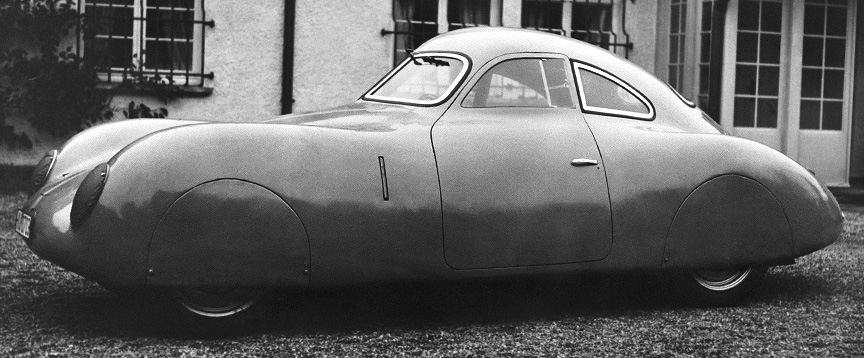
The rumor says SS Lieutenant Colonel Bodo Lafferentz, the board member of Volkswagenwerk, totalled the car beyond repair in the end of 1939, but the above photos seem to have been made later than 1939…
No. 2 Porsche Type 64
The second car, chassis 38/42, was finished by the end of 1939. The windscreens were slightly curved compared to no. 1. The nose grille was extra wide (wider than the number plate on it), the rear lamps were different and in different locations. The car also had an antenna. It is not clear if the car was originally made with these thin window frames in 1939. They might be a later evolution.
There was a road accident with the car in around 1941. The aluminium left front fender was ripped into pieces and the door was damaged, but not beyond repair. Note the long front grille. The photo also shows how the doors opened – slightly upwards, not just to the sides.
In 1944 the car was taken to Austria when Porsche design company moved away from the war. In 1945, US soldiers cut the roof off and joyrided it. Some of the remains were later sold to Otto Mathé together with car no. 3.
No. 3 Porsche Type 64
The third car was completed in summer of 1940. It had longer semaphores than the earlier cars. The body and wheels were painted black. The rear lamps looked like the ones on the 38/42, but were positioned a bit differently.
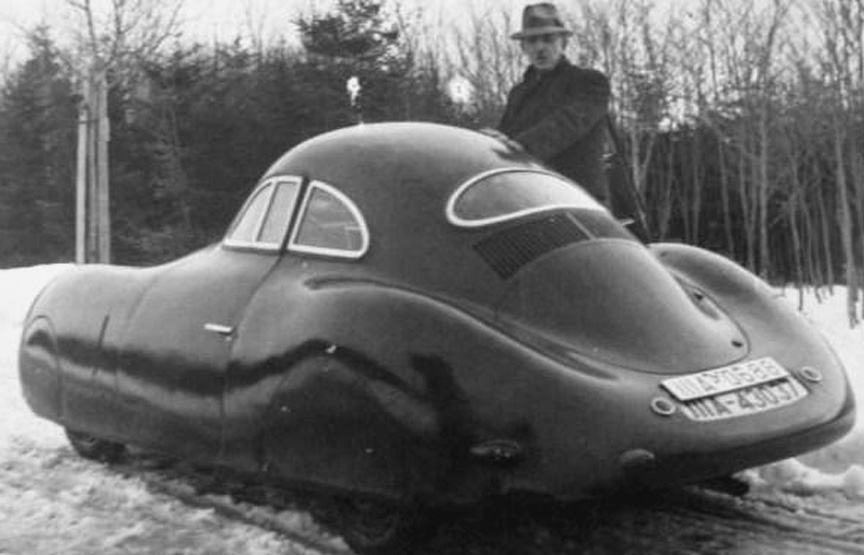
The Berlin-Rome road rally had been postponed from 1938 to 1939, then to 1940 and 1941, but never happened. In 1940 Japan had joined the military alliance of Germany and Italy, and a Berlin-Rome-Tokyo road rally was thought of, but didn’t happen.
As the Porsche design office had moved to Gmünd, Carinthia in Austria in 1944, naturally so did no. 3. In Austria the car got a local license plate ‘K 45-240’ where K standed for Kärnten (Carinthia, a state of Austria). Ferry Porsche had the car rewamped in 1947, supposedly at Carozzeria Pininfarina in Italy. The car got new grille, was fitted with two windscreen wipers under the windscreens and was painted silver.
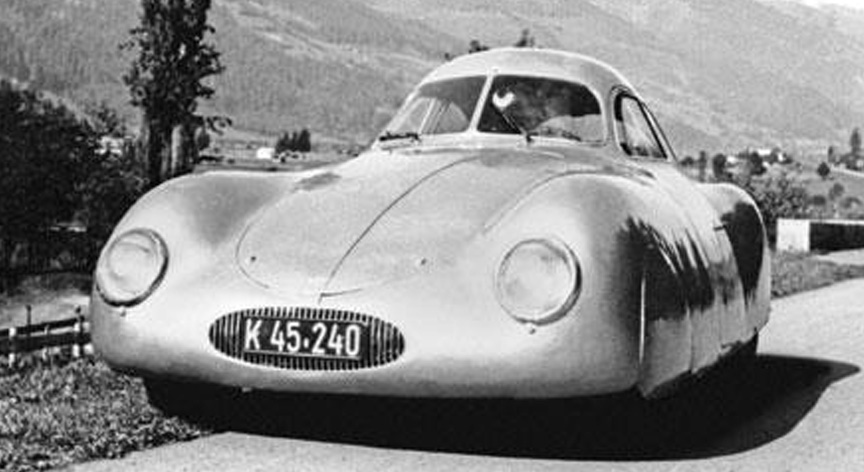
In 1949 the car was sold to Otto Mathé. On the contract it read Volkswagen Sport, type 64. Mathé also bought a second chassis and other parts. The new license plate was T 2222, where T standed for the Tyrol county in Austria. Otto Mathé used to be a motorcycle racer, who started to race in 1923. In 1934 he had an accident after which his right hand remained paralysed. So, when he bought the type 64 from Ferry Porsche, he converted it into right-hand-drive because he could use only his left hand to operate the gear lever. He also converted the brake system from cables to hydraulic.
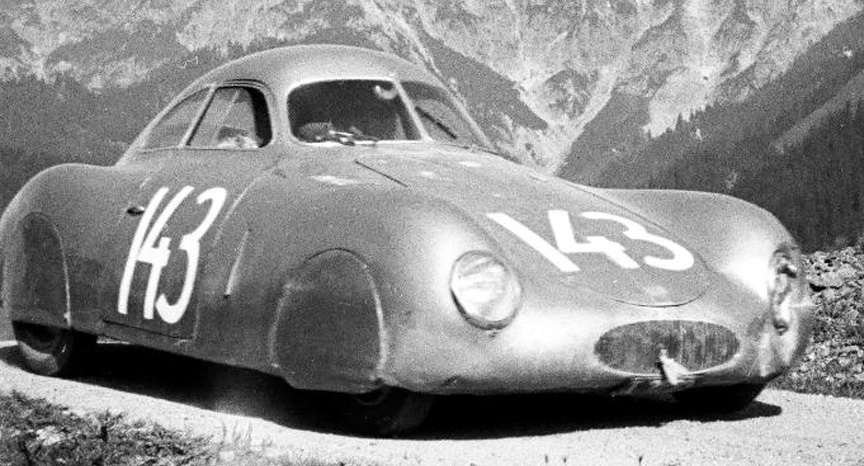
Austrian Alpine Rally was important for Mathé and while he had to retire in 1949, he finished in 1950. In addition to the many motorcycle classes, cars were divided into 8 classes, which meant there were very few cars in each class. The fastest vehicles at the rally were the motorcycles over 250 cc. They were followed by motorcycles up to 250 cc, then sports cars over 2000 cc, sports cars up to 2000 cc, motorcycles with sidecars (500 cc and 1200 cc classes), then came Otto Mathé in the 1100 cc sports cars class, followed by other car classes and finally the 125 cc motorcycle class.
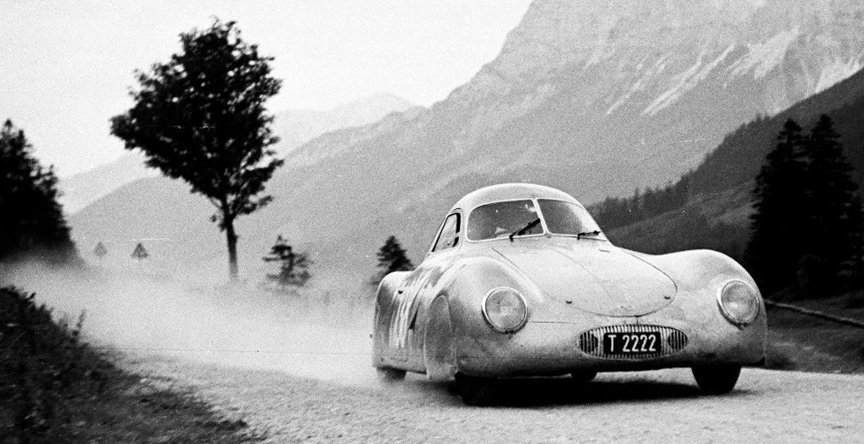
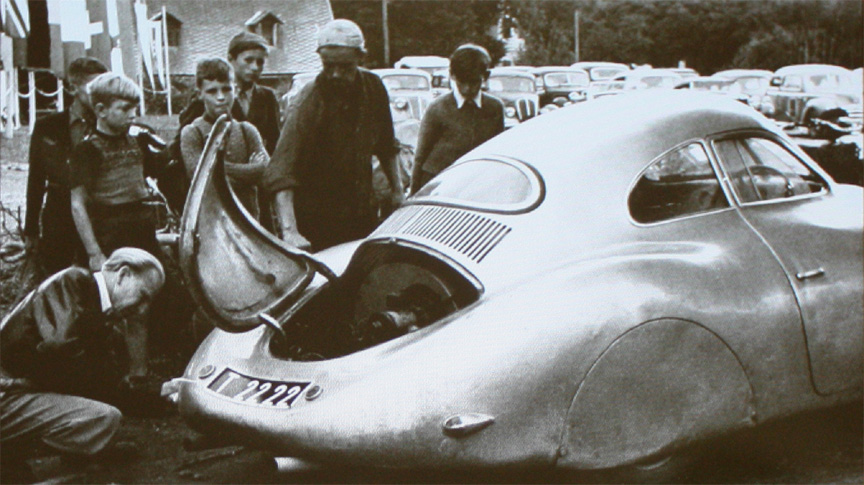
Although Mathé was the single entry in his class, as he managed to finish the rally, he was awarded with different awards – Gold medal (given to every class winner), Edelweiss (given to most class winners), Alpine Cup (given to many class winners). The race was started by 70 solo motorcycles, 10 with sidecars, 43 touring cars and 19 sports cars – 142 in total. The finish saw 47 solo motorcycles, 6 with sidecars, 27 touring cars and 8 sports cars – 88 in total.

Despite having only one palm for gearshift and steering, Mathé was a dedicated racer. He did everything to go fast. Even if the dirty windscreen of the type 64 or the later 356 had to be kicked out for better vision. Being a fierce racer meant he also crashed here and there.
Before the 1951 rally season the car was dismantled for full repaint and was painted turquoise, also inside the cockpit.
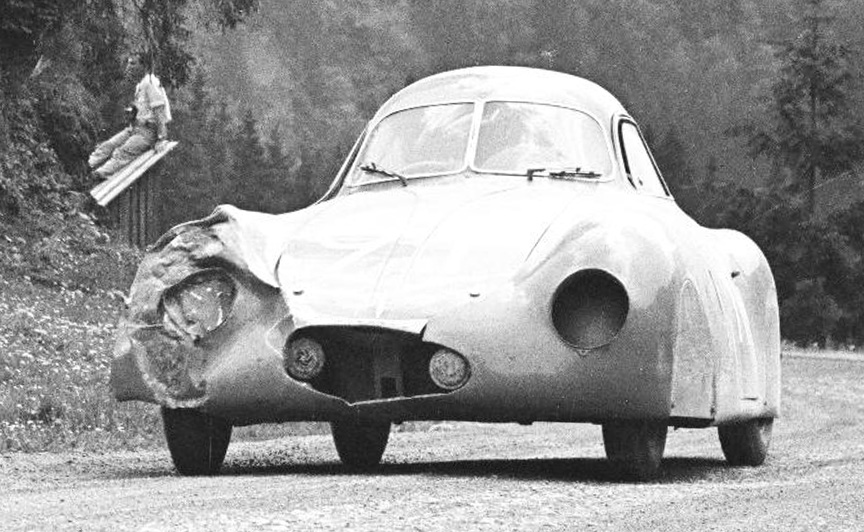
When the car was repaired after the accident, the old-school semaphores were removed and PORSCHE-lettering was fixed on the nose.
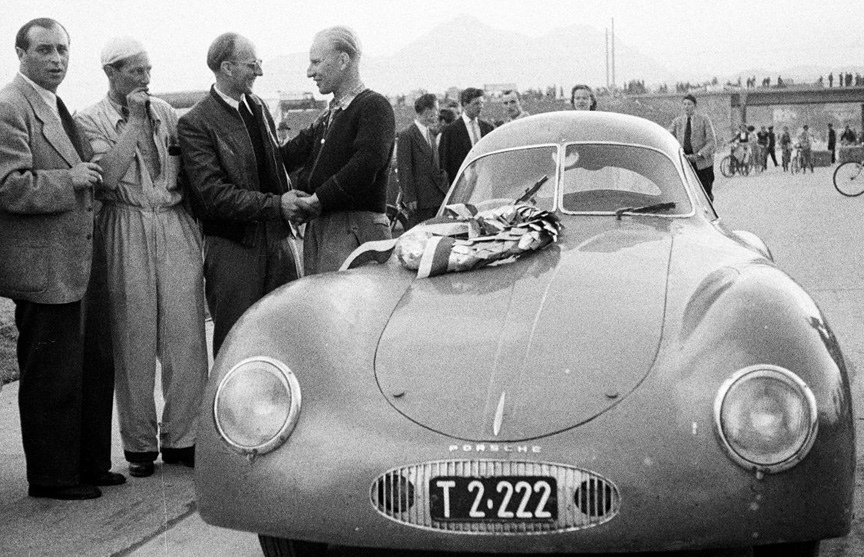
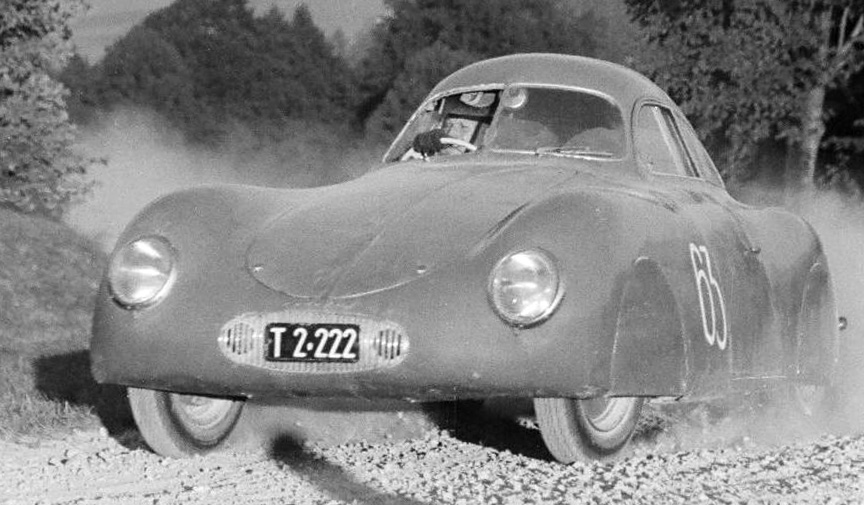
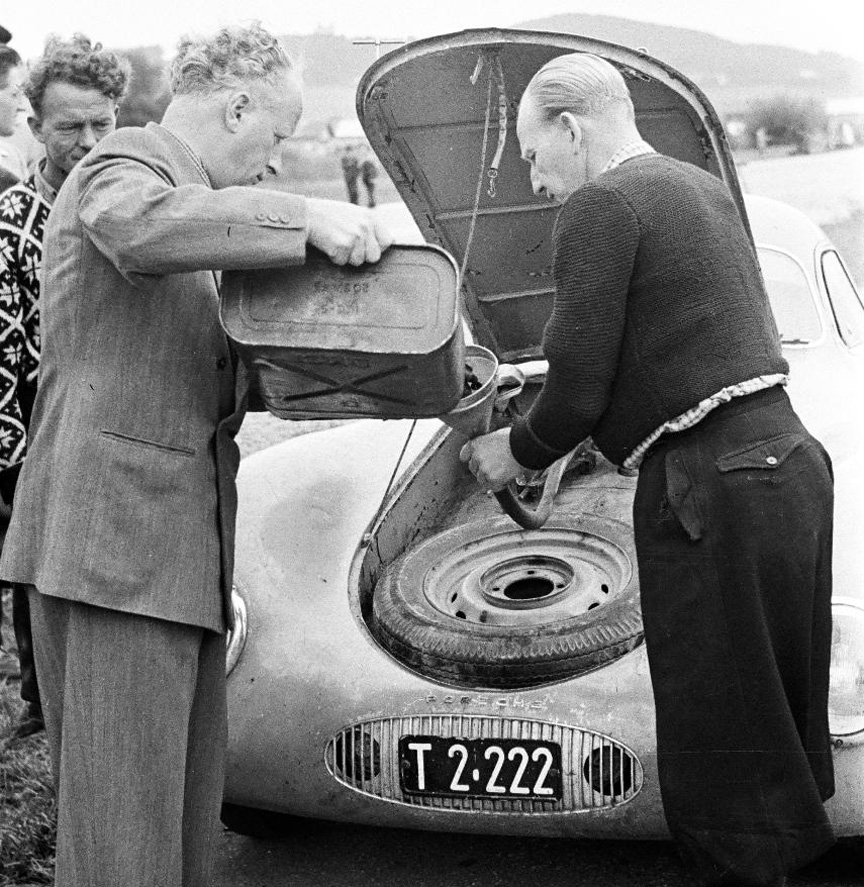
In the nineteen fifties Otto Mathé was Niki Lauda’s childhood idol (both Austrians, Mathé born in 1907, Lauda in 1949).
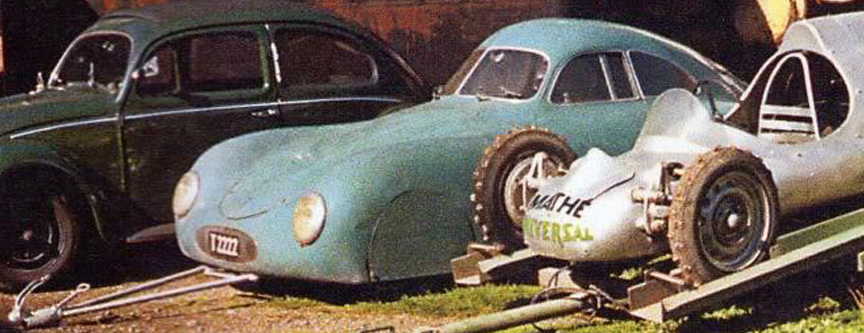
It was probably in the 1970’s when Mathé had the car painted back to silver (the cockpit remained turquoise). Otto Mathé died in 1995 at the age of 88. The car was sold in 1997 to Thomas Gruber and in 1998 converted back to left-hand-drive by Barbach in Austria. The car was sold on to Schörghuber company in 2008.
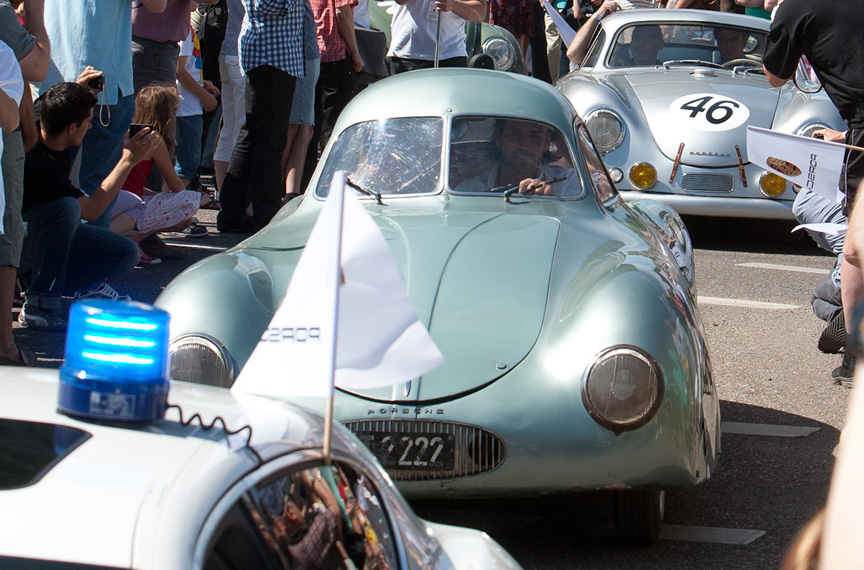
The Differences Between the Porsche Type 64 Cars
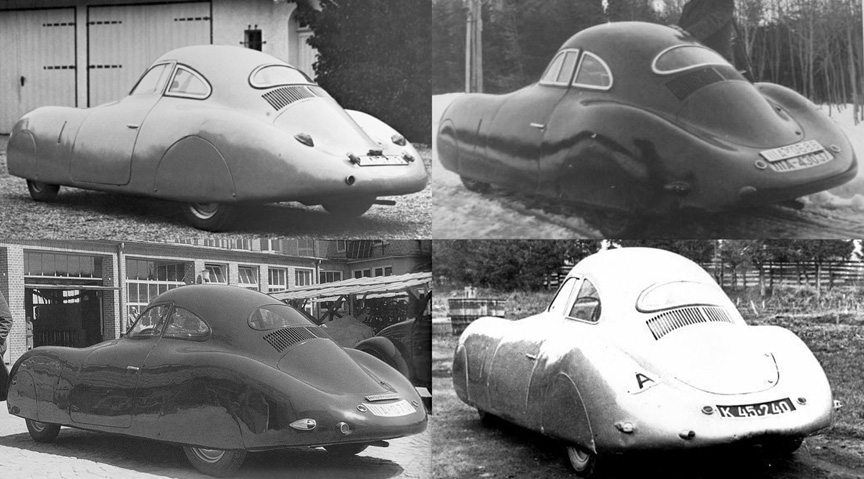
| Data | No.1 (1939) | No.2 (1939) | No.3 (1940) |
| chassis number | 38/41 | 38/42 |
38/43 restamped as 38/41 (or chassis 38/41 from no.1)
|
| engine number | 38/41 | 38/43 |
original 38/46, but later 38/43 fitted by Otto Mathé
|
| distinctive features | flat windscreens and short semaphores | curved windscreens and short semaphores |
curved windscreens and longer semaphores
|
| colour | gray metallic | dark blue, then painted black after accident |
black, then silver, then turquoise, then silver again
|
| known license plates | IIIA 0703 | IIIA 0701 |
German IIIA 0687, IIIA 43037/IIIA 0688, Austrian K45240, T2222
|
| front grilles | 2 grilles | 1 very wide grille |
2 grilles, later 1 large grille
|
| wipers | 1 wiper fixed above the windscreen | 1 wiper fixed above the windscreen |
1 wiper fixed above the windscreen, later 2 wipers fixed below the windscreens
|
| rear lamps | above rear fenders | on rear corners | on rear sides |
| rear brake lamps (on the sides of the license plate) | protruding | almost flush with body |
almost flush with body
|
| wheel color | silver | silver |
black, later silver
|
| known window trim – windscreens | shiny metal in rubber | thin black |
thin black, later thin shiny metal
|
| known window trim – door window | no trim | thin black |
thin black, then shiny metal in rubber, then thin shiny metal
|
| known window trim – side window | shiny metal in rubber | thin black |
thin black, then shiny metal in rubber, then thin shiny metal
|
| known window trim – rear window | shiny metal in rubber | ? |
thin black, then shiny metal in rubber
|
| antenna | no antenna | antenna |
space for antenna
|
| history | 1939: totalled and dismantled, chassis probably used for car no.3 | ~1941: repairable accident. 1945: roof cut off by US soldiers. 1949 or later: parts sold to Otto Mathé, engine installed in body no.3. 2011 recreated by Nostalgicar for Prototype Museum Hamburg. |
1949 until 1995 owned by Otto Mathé
|
The Porsche type 64 KdF Berlin-Rome car is acknowledged as the original ancestor of all the subsequent Porsche sports cars to follow.
Replica Type 64
Body recreation by Hubert Drescher (2009)
Ordered by Porsche, Karosseriebau Drescher took the job to make a replica body. It took 1.5 years to make it. The body was stamped with 38/42, although it has nothing to do with the original 38/42.
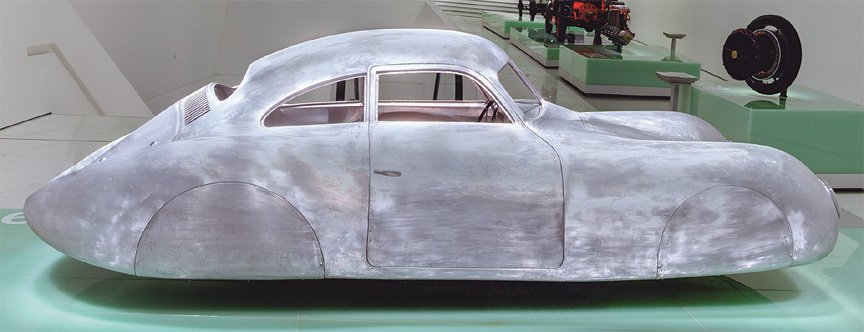
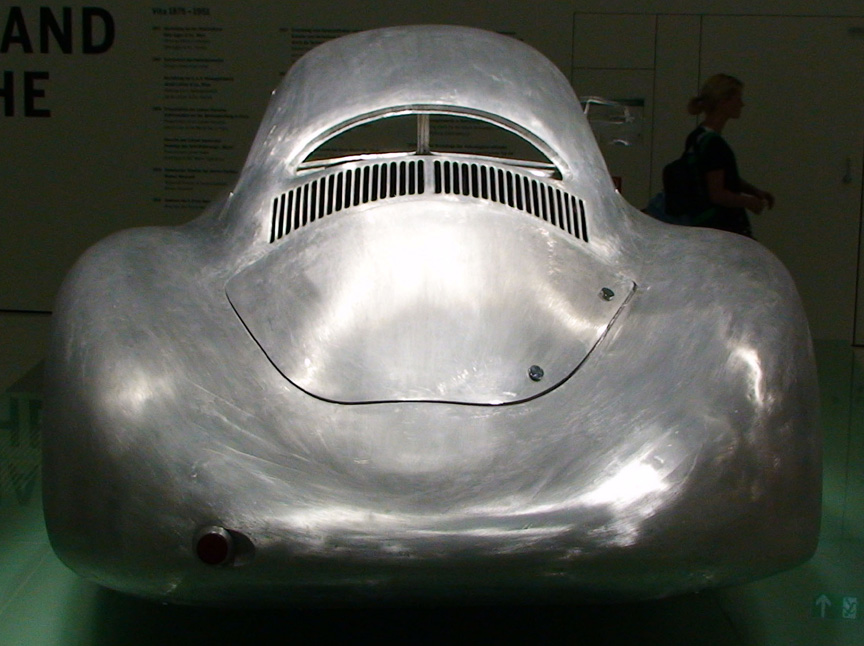
Recreation by Nostalgicar (2011)
The car was created on order of the Hamburg Prototyp Museum (www.prototyp-hamburg.de) and finished in 2011. Some original 38/42 parts were used.
Replica by Barbach (2014)
It is naturally a huge work to make a car and Michael Barbach’s team spent around 7000 man hours in 6 years to make this replica. The car was finished in May 2014. The location of the windscreen wiper, the window frames and rear lamps suggest the car is mimicking car no.1. Barbach’s car is registered with number plate BN 2 JWL, but on the events the car is fitted with IIIA 0703, which was the number plate of the first original chassis 38/41.
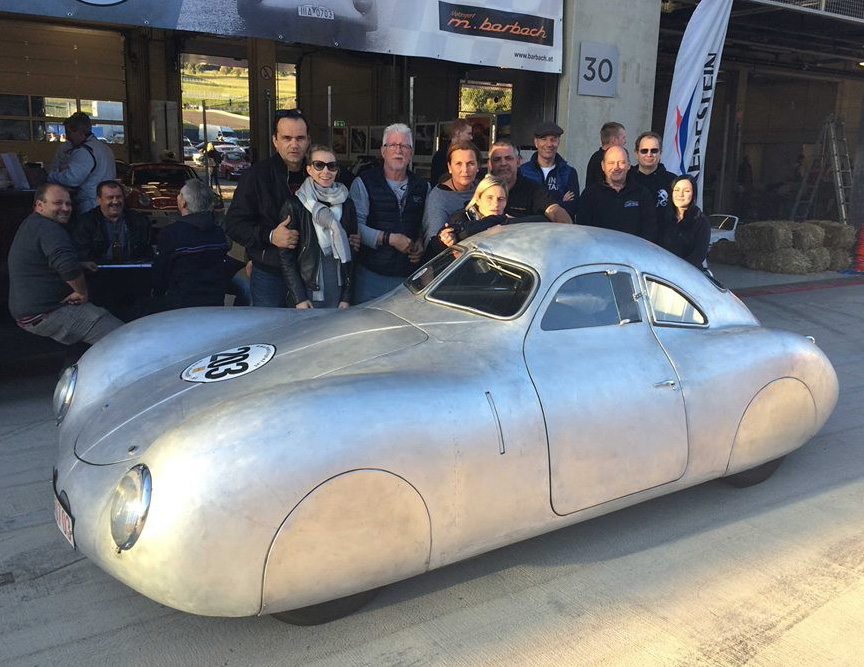


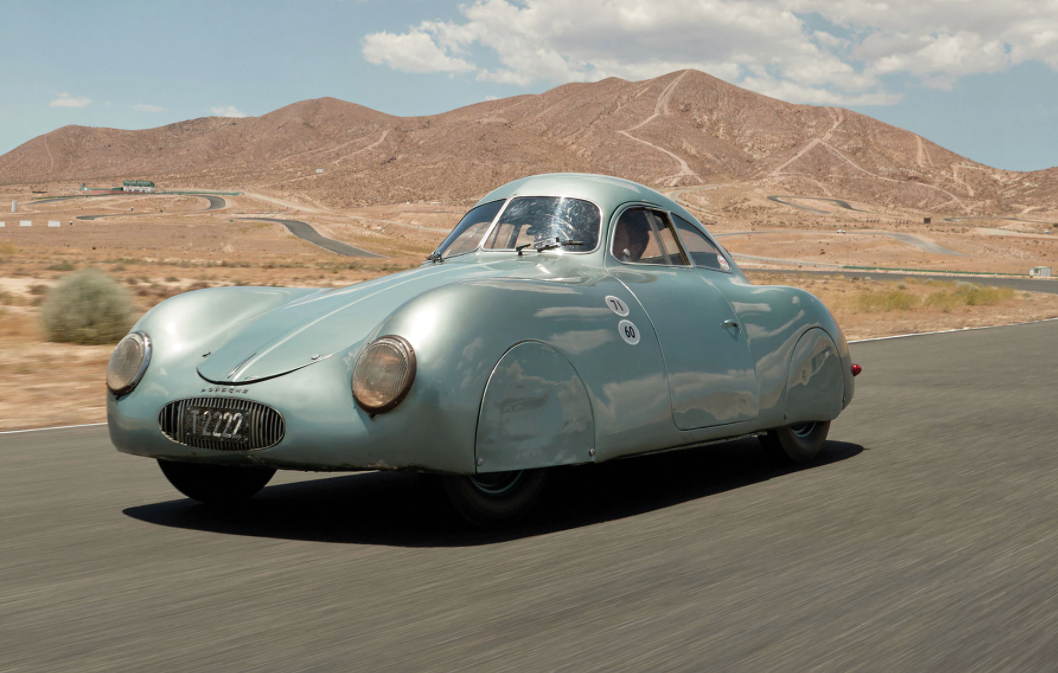

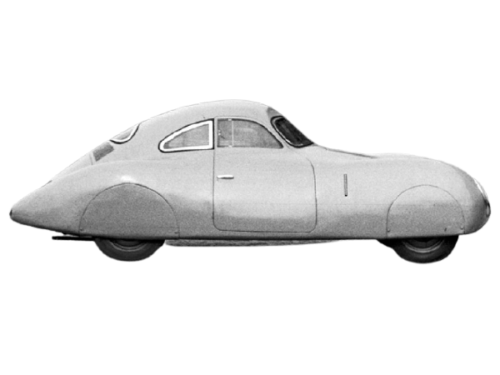
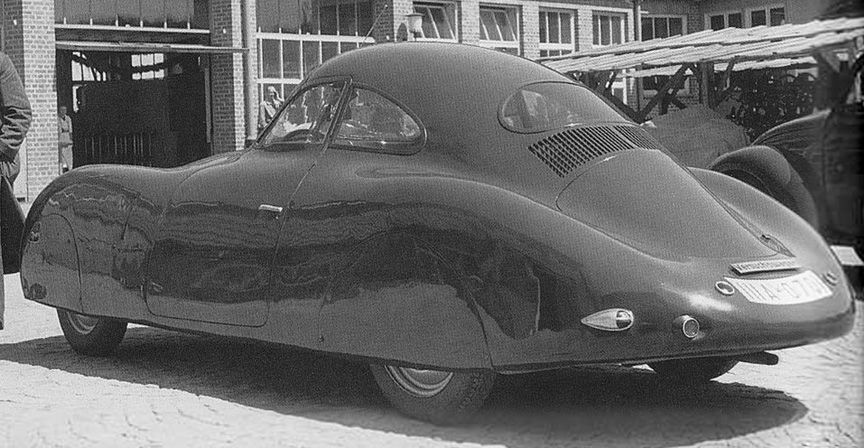
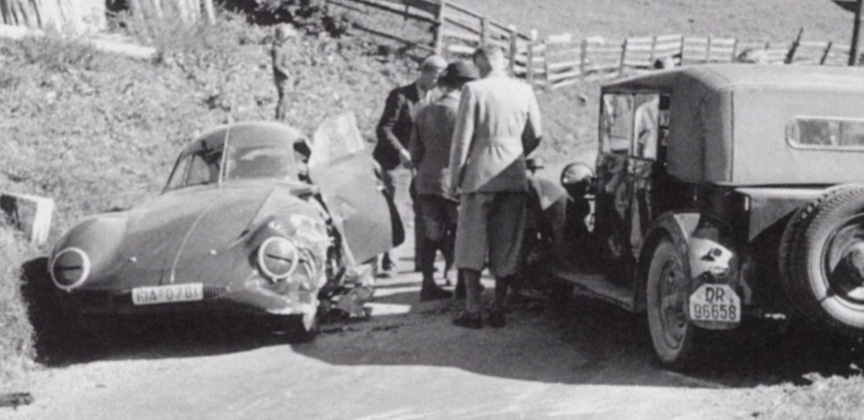
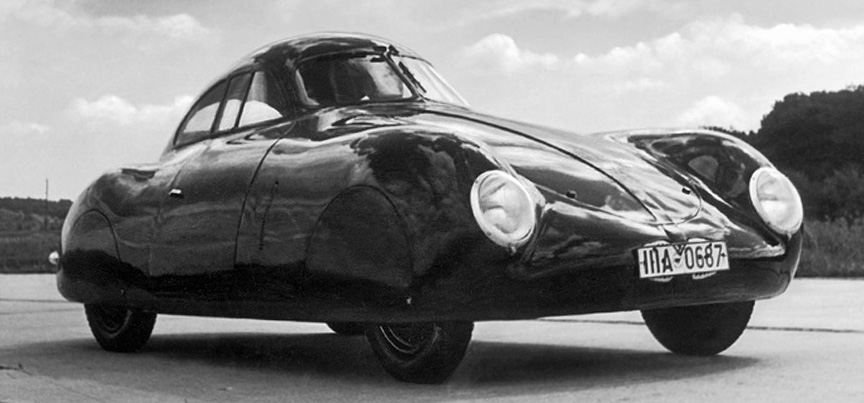
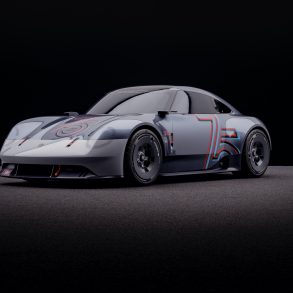
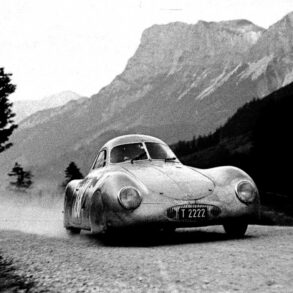
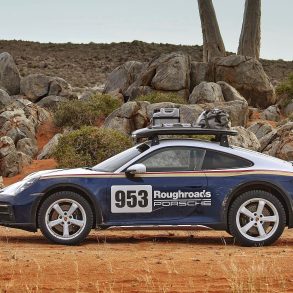
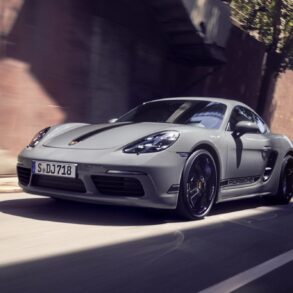
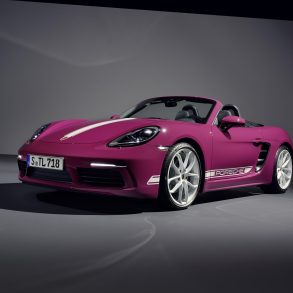
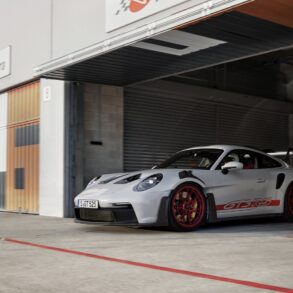
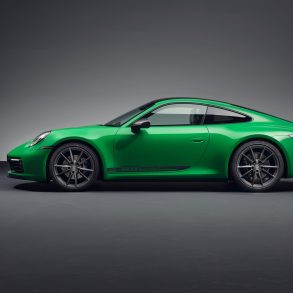
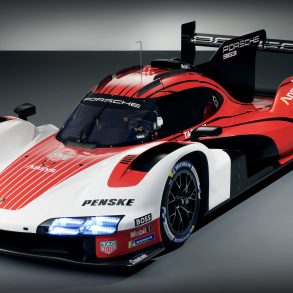

Hello, I attended the 2016 Paridis Porche event in St Tropez. I Made a video of the Type 64 on display at the event and recently uploaded to my YouTube channel (@Channelgriffin) with a request for information on the car. After doing some research I have come to realize that this is most likely a re-creation. Do you have any details on the car that was on display in St. Tropez?
Thank you in advance!!🙏🏻
0